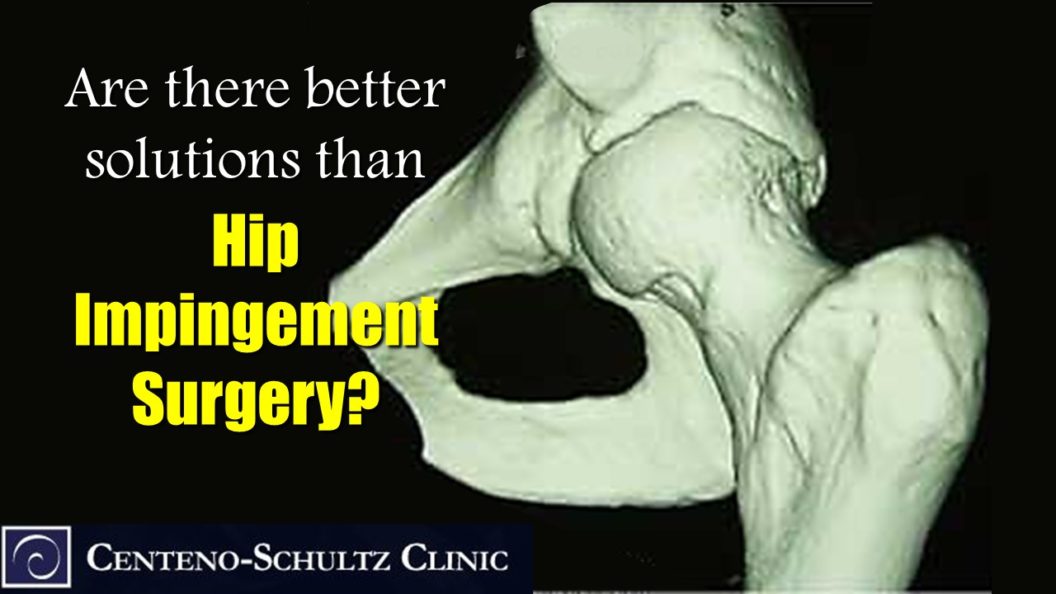Hip impingement surgery was a relatively unknown procedure up until about the last decade, when it skyrocketed to the second most common surgery on the hip (just behind hip replacement). Why? Arthroscopic surgery was introduced to the hip, and this opened doors for more hip procedures. The question of why isn’t nearly as important as the question of do you really need a hip impingement surgery?
Before we dig into the research, or lack thereof, let’s review hip impingement and the surgery used to “fix” it.
Hip Impingement and Hip Impingement Surgery
Femoral acetabular impingement (FAI) is the medical term for what is commonly known as “hip impingement.” The idea is that hip impingement occurs when bone spurs, which are extensions of bone, form on the ball or socket of the hip joint. The ball is the head of the femur bone (upper-leg bone), and the acetabulum is the indentation in the pelvic bone where the ball fits. The idea further is that these bone spurs wear down the cartilage (the protective joint cushion) as they press against it, creating FAI.
So with bone spurs having such a bad reputation, it’s understandable that patients may be very concerned when they find out they have them. To learn more about bone spurs, watch Dr. Centeno’s video below:
Since arthroscopic surgery has made the hip more easily accessible, surgeons now like to go in and remove these bone spurs and/or even reshape the hip. However, in most cases, whether it’s an injury or simply bad anatomy, bone spurs form to protect a hip joint, not destroy it. To learn more on hip impingement and bone spurs in the hip, watch Dr. Centeno’s video below:
So what does the research on FAI surgery show?
Research on Hip Impingement and Arthroscopy
First, the research, even a decade after FAI surgery exploded in popularity, is severely lacking. Surgeon’s have been performing hip impingement surgery for a good 10 years, and there isn’t a single high-level study that shows performing this highly invasive surgery is any better than just leaving the hip alone or performing physical therapy. In addition, the surgery causes damage in the process: pulling traction disrupts a major nerve, and we’ve seen severe tissue damage caused by hip arthroscopy as well.
A recent study that compared FAI surgery to physical therapy found no significant differences between the two groups in the areas of both functional abilities and pain scores. While this isn’t a perfect example of a randomized controlled trial (a high-quality study using test and control subjects) on hip impingement surgery, unfortunately, it’s the only one we have that compares FAI surgery to no surgery. And the fact is, FAI surgery performed very poorly in this study, poorly enough to make us question why the surgery is even being done.
We suspect, however, that this study is the beginning of the end for FAI surgery. It will likely follow in the footsteps of other elective orthopedic surgeries, such as meniscus surgery, that are slowly sinking ships in the field of surgical orthopedics.
Why You Probably Don’t Need Hip Impingement Surgery
First, it’s important to understand that chronic pain in a structure doesn’t necessarily equate to the need for surgery on that structure. Orthopedic surgery, however, generally follows the idea that if a structure hurts, for example the hip, that structure is the problem and it needs to be surgically corrected. Sometimes this is true (e.g., following severe traumatic injuries), but in most cases, chronic pain isn’t that simple; there are neurological, mechanical, and chemical processes that must all be considered when treating pain.
So if your hip hurts and your MRI shows a bone spur on the socket of your hip joint, going in and cutting that bone spur off the joint when it’s possible that hip pain is due to something else entirely, such as an irritated nerve in the lumbar spine, is just a bad idea that can only lead to more problems later. And as you know if you watched Dr. Centeno’s bone spur video above, bone spurs typically form as a symptom of some other problem as the body’s way of protecting the joint from further damage. Removing the bone spur not only doesn’t address the actual problem but also leaves the joint at risk until a new bone spur is able to reform.
So if you’re diagnosed with hip impingement and bone spurs, it’s important to understand that just because a we can perform a hip impingement surgery doesn’t mean we should. It’s a good idea to see an interventional orthopedic physician, who can determine what is actually causing your bone spurs and in most cases provide nonsurgical treatment for the problem.
